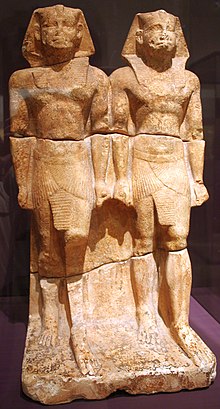
Back Nioeserre Afrikaans ني أوسر رع Arabic نى اوسر رع ARZ Niuserre Catalan Niuserre Czech Niuserre German Nyuserra Spanish Nyuserra-Iny Basque نیوسررع Persian Niuserra Finnish
| Nyuserre Ini | |
|---|---|
| Niuserre Ini, Neuserre Ini, Nyuserra, Newoserre Any, Rathoris | |
 Double statue portraying Nyuserre as both a young man and an old man, Museum of Egyptian Art in Munich | |
| Pharaoh | |
| Reign | 24 to 35 years in the late 25th century BCE[note 1][note 2] |
| Predecessor | Shepseskare (most likely) or Neferefre |
| Successor | Menkauhor Kaiu |
| Consort | Reptynub, at least another queen whose name is lost, possibly two |
| Children | Khamerernebty ♀, Reputnebty ♀, Sheretnebty ♀, Khentykauhor ♂, Okpo♂ Unlikely: Menkauhor Kaiu ♂ |
| Father | Neferirkare Kakai |
| Mother | Khentkaus II |
| Burial | Pyramid of Nyuserre Ini |
| Monuments | Built ex-nihilo: Pyramid of Nyuserre Ini Pyramid Lepsius XXIV Lepsius XXV Sun temple Shesepibre Completed: Pyramid of Neferirkare Kakai Pyramid of Neferefre Pyramid complex of Khentkaus II Sun temple of Userkaf Renovated: Mortuary complex of Menkaure Uncertain: Temple of Satet |
| Dynasty | Fifth Dynasty |
Nyuserre Ini (also Niuserre Ini or Neuserre Ini; in Greek known as Rathurês, Ῥαθούρης) was an Ancient Egyptian pharaoh, the sixth ruler of the Fifth Dynasty during the Old Kingdom period. He is credited with a reign of 24 to 35 years depending on the scholar, and likely lived in the second half of the 25th century BCE. Nyuserre was the younger son of Neferirkare Kakai and queen Khentkaus II, and the brother of the short-lived king Neferefre. He may have succeeded his brother directly, as indicated by much later historical sources. Alternatively, Shepseskare may have reigned between the two as advocated by Miroslav Verner, albeit only for a few weeks or months at the most. The relation of Shepseskare with Neferefre and Nyuserre remains highly uncertain. Nyuserre was in turn succeeded by Menkauhor Kaiu, who could have been his nephew and a son of Neferefre.
Nyuserre was the most prolific builder of his dynasty, having built three pyramids for himself and his queens and completed a further three for his father, mother and brother, all in the necropolis of Abusir. He built the largest surviving temple to the sun god Ra constructed during the Old Kingdom, named Shesepibre or "Joy of the heart of Ra". He also completed the Nekhenre, the Sun temple of Userkaf in Abu Gorab, and the valley temple of Menkaure in Giza. In doing so, he was the first king since Shepseskaf, last ruler of the Fourth Dynasty, to pay attention to the Giza necropolis, a move which may have been an attempt to legitimise his rule following the troubled times surrounding the unexpected death of his brother Neferefre.
There is little evidence for military action during Nyuserre's reign; the Egyptian state continued to maintain trade relations with Byblos on the Levantine coast and to send mining and quarrying expeditions to Sinai and Lower Nubia. Nyuserre's reign saw the growth of the administration, and the effective birth of the nomarchs, provincial governors who, for the first time, were sent to live in the provinces they administered rather than at the pharaoh's court.
As with other Old Kingdom pharaohs, Nyuserre benefited from a funerary cult established at his death. In Nyuserre's case, this official state-sponsored cult existed for centuries, surviving the chaotic First Intermediate Period and lasting until the Twelfth Dynasty of the Middle Kingdom. In parallel, a spontaneous popular cult appeared, with people venerating Nyuserre under his birth name "Iny". In this cult, Nyuserre played a role similar to that of a saint, being invoked as an intercessor between the believer and the gods. It left little archaeological evidence and seems to have continued until the New Kingdom, nearly 1000 years after his death.
- ^ Verner 2001b, p. 589.
- ^ Hawass & Senussi 2008, p. 10.
- ^ LACMA 2016.
- ^ Altenmüller 2001, p. 599.
- ^ Encyclopædia Britannica 2016.
- ^ Clayton 1994, p. 60.
- ^ Ziegler 2007, p. 215.
- ^ Malek 2000a, p. 100.
- ^ Rice 1999, p. 141.
- ^ Van de Mieroop 2011, p. 55.
- ^ Strudwick 2005, p. xxx.
- ^ von Beckerath 1999, p. 283.
- ^ Hornung 2012, p. 491.
- ^ Nolan 2012, p. 3.
- ^ Strudwick 1985, p. 3.
- ^ Hayes 1978, p. 58.
- ^ Verner 2001a, p. 404.
- ^ von Beckerath 1997, p. 56.
- ^ a b Leprohon 2013, p. 40, see also footnote 58.
- ^ a b Leprohon 2013, p. 40.
- ^ Clayton 1994, p. 61.
- ^ Leprohon 2013, p. 40, see also footnote 59.
- ^ von Beckerath 1999, p. 59.
Cite error: There are <ref group=note> tags on this page, but the references will not show without a {{reflist|group=note}} template (see the help page).
© MMXXIII Rich X Search. We shall prevail. All rights reserved. Rich X Search
